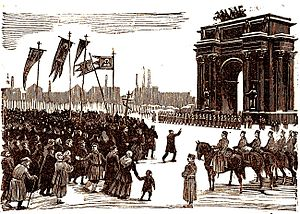Continuing with the origins of the Soviet Union, this article will mention the Petrograd Soviet, precursor council to the Soviet Union. It will also mention a few important figures of Soviet Russian history:
The first Petrograd Soviet actually formed back when the tsar and Russian Empire were still in charge of the nation. This first workers' council was known as the Petrograd Soviet of Workers' Delegates. It arose from January-February 1905 meetings of workers at the apartment of Russian revolutionary
Vsevolod Mikhailovich Eikhenbaum. Soviet is simply a Russian word for 'workers' council', so while the Cold War has made soviet a common English word as well as a Russian one, an literal English translation would make this the 'First Petrograd Council of Workers and Delegates'. The council would have between 400 to 500 members who represented the common worker. These members were elected by about 200,000 industrial workers according to the records written by Leon Trotsky.
Many of the meetings of the first Petrograd Soviet occurred during the 1905 Russian Revolution, a precursor to the transformative February Revolution previously mentioned in one of the previous Cold War posts. Many historians state that the 1905 revolution set the stage for the 1917 February Revolution. The revolution lasted from January of 1905 to June 16th of 1907, lasting about 2 years and 4 months. According to Sidney Harcave, historian and author of The Russian Revolution of 1905, four major problems led to the revolution and, by extension, the 1st Petrograd Soviet: the lack of land and financial opportunities for newly emancipated peasants, repression of national minorities, lack of protection for the working class, and a rise of educated college students interested in reform of the current tsarist system. As historian James Defronzo put it: "At the turn of the century, discontent with the Tsar’s dictatorship was manifested not only through the growth of political parties dedicated to the overthrow of the monarchy but also through industrial strikes for better wages and working conditions, protests and riots among peasants, university demonstrations, and the assassination of government officials, often done by Socialist Revolutionaries."

Demonstration during 1905 Russian Revolution, image from Wikimedia
The First Petrograd council would have between 400 to 500 members who represented the common worker. These members were elected by about 200,000 industrial workers according to the records written by Leon Trotsky. The council would own the means of production on behalf of 5 trade unions and 96 factories around Saint Petersburg.
Three socialists groups were part of the First and Second Petrograd Council: The Bolsheviks, the Mensheviks, and the Esers (Socialist Revolutionary Party). In the 1905 workers council, the Mensheviks were the most influential and originally, there was no Bolshevik representation in the 1907 Petrograd.
Eventually, the Bolsheviks rose in popularity in a series of events known as the Bolshevization of soviets. The Bolsheviks, in response, began increasing the printing of Pravada: a series of newspapers advocating Marxist-Leninist socialism and the radical far-left ideas the Bolsheviks were known for. The first Soviet ceased to exist on December 1905 when many leaders of the council were arrested, the second lasted throughout the October Revolution and into the creation of Soviet Russia.
You are a great writer sir....we know for you very important information...this article learn help us..thank u sir